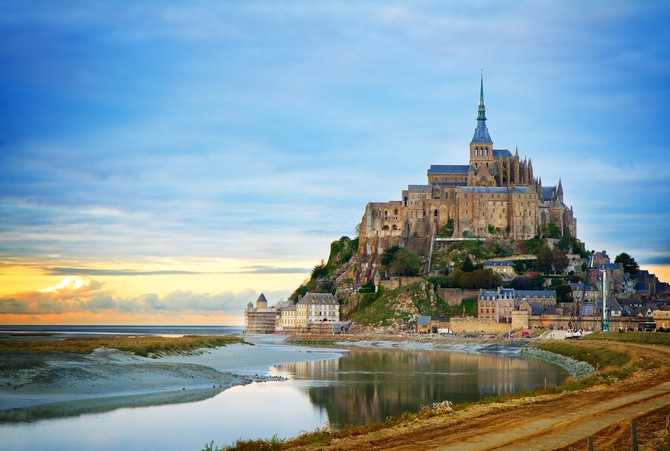BAYEUX, Normandy: Normandy is blessed with stunning landscapes, a rich history and some of the best cheese and cream in all of Europe. Sprawled across France’s northwestern corner, the spectacular cliff-lined coast and rolling green fields have inspired centuries of creative talents, including Impressionist painter Claude Monet.
Lapped by the Channel, Normandy is home to a sandy coastline and was the site of the D-Day landings in World War II, when US, British and Canadian forces landed on five beaches along the heavily fortified coast in 1944.
Despite the tall, wind-rustled grasses and peaceful dunes, memories of the brutal episode in the war reveal the grittier side of Normandy, an area that was home to the Viking warriors who conquered England in 1066 and were said to have terrorized parts of Europe.
For visitors who wish to understand more about this fascinating history, and enjoy gastronomic delights at the same time, Normandy is well worth a visit. From the Bayeux Tapestry to the magnificent island commune of Mont St-Michel, there are plenty of attractions to visit in the area.
If you are planning a trip to Europe’s cream capital — Normandy is famed for its dairy ventures — look no further than this guide. Be sure to pack a raincoat, however, as the area is known for its almost-constant drizzle. Temperatures remain mild throughout the year, and range between 10 and 25 degrees Celsius.
The D-Day landing beaches
A visit to the landing beaches in Normandy will prove a sobering start to your trip, but it is crucial if you wish to understand how the largest seaborne invasion in history was carried out. The June 6, 1944, operation sparked the liberation of German-occupied northwestern Europe, which eventually led to an Allied victory on the western front of the war.
Wartime planners divided the stretch of golden coastline into five sectors, which are still known by their code names. Sword, Juno and Gold were stormed by British and Commonwealth troops, while the Americans came ashore on Omaha and Utah.
One of the most visited sites is the poignantly huge American cemetery at Colleville-sur-Mer, which houses the graves of 9,387 US military personnel. Visitors can also stop at the town of Arromanches, where Mulberry harbor, which facilitated 2.5 million men in coming ashore, still lies exposed offshore.
Bayeux
The 1,000-year-old town of Bayeux, with its medieval cobbled streets and Norman-Gothic cathedral, is breathtaking. Tourists can flock to the overpowering Cathedral of Our Lady of Bayeux, wander the history-dipped streets, then pay a visit to the undisputed jewel of the area, the Bayeux Tapestry.
The 70-meter-long embroidery, on show at the Bayeux Museum, depicts the story of William the Conqueror’s invasion of England in 1066. William insisted he was the rightful heir to the English throne after the death of King Edward the Confessor, and when the Anglo-Saxon Harold Godwinsson was anointed instead, an irate William stormed the beaches of England and conquered his detractors at the Battle of Hastings on Oct. 14, 1066.
French legend has it that the tapestry was created by his wife Queen Matilda with her ladies in waiting. Although scholarly analysis has not dug up any evidence on exactly who sewed the epic embroidery, it is sometimes called “La Tapisserie de la Reine Mathilde” (“The Tapestry of Queen Matilda”) in France.
The Pays d’Auge
Normandy’s reputation for cream, cheese and apples rests on the meadows and orchards of the Pays d’Auge. This idyllic slice of rural France is dotted with hungry cows chewing on long grass, dairy farms, and long stretches of tree-topped hills and deep valleys. The tiny village of Camembert is worth a visit due to its important place in history — and our diets — as the home of the deliciously pungent cheese created there during the days of the French Revolution.
Half-timbered houses and farms can be seen throughout the area, one that is perfect for bicycle rides ending with a visit to Pays d’Auge’s principal town of Lisieux. The town is France’s second-ranking Roman Catholic pilgrimage destination after the town of Lourdes, due to the Basilica of St. Thérèse, which was opened in 1937.
Rouen
Rouen is Normandy’s largest city and is home to a major port, which is the closest to Paris. The bustling city straddles the Seine river and boasts a medieval core, with tangled streets that are both authentic and restored — Allied bombing during World War II ravaged the city and led to many of the riverbanks and pathways being obliterated.
For history buffs, the city is most recognizable as the place where Roman Catholic St. Joan of Arc was burned at the stake in 1431, and as the home of the awe-inspiring Rouen Cathedral. Built over three centuries, the cathedral has seen the crowning of various dukes of Normandy.
Several are buried in the cathedral, which also houses the heart of England’s King Richard I, who ruled in the 12th century. The famed king was known as Richard the Lion Heart, and is remembered for battling the first sultan of Egypt and Syria, Saladin, during the Crusades. Fast forward to the 19th century, and the much-loved artist Monet made it his mission to document the beautiful facades of the cathedral in a series of paintings completed in the 1890s.
Mont St. Michel
It is impossible to miss the abbey of Mont St. Michel as you drive toward it through twisting country lanes — it is awe-inspiring even at a distance. The abbey was built on the highest point of a tiny island near the frontier between Brittany and Normandy more than 1,000 years ago.
What began as a religious sanctuary, built on a rock in 708 AD by the bishop of the nearby town of Avranches, was developed into the megastructure we see today between the 11th and 16th centuries. It quickly became one of the most important places of medieval pilgrimage, and was declared a UNESCO World Heritage Site in 1979.
Nowadays the site is a busy tourist trap, so make sure to visit early in the day or be prepared to climb the stone stairways in order to escape the hubbub below. Whether you arrive by car or coach, you will park in a set of car parks about 20 minutes away from the island, and can choose to travel by a free shuttle or pay a fee for a horse-driven cart.
Normandy is a mere three-hour drive from Paris, so jetting into the capital and organizing a car or coach trip is the best way to soak in the delights of this food, history and art-rich stretch of France.
Visit Normandy for its rich history and sigh-worthy cheeses
Visit Normandy for its rich history and sigh-worthy cheeses

Venice expands its day-tripper tax program in bid to combat overtourism

- A UNESCO body decided against putting Venice on its list of cultural heritage sites deemed in danger after the tax was announced
- Opponents of the day-tripper fee say it has done nothing to discourage tourists from visiting Venice even on high-traffic days
VENICE, Italy: Venice is charging day-trippers to the famed canal city an arrivals tax for the second year starting Friday, a measure aimed at combating the kind of overtourism that put the city’s UNESCO World Cultural Heritage status at risk.
A UNESCO body decided against putting Venice on its list of cultural heritage sites deemed in danger after the tax was announced. But opponents of the day-tripper fee say it has done nothing to discourage tourists from visiting Venice even on high-traffic days.
Here’s a look at Venice’s battle with overtourism by the numbers:
5-10 euros (about $6-$11)
The fee charged to visitors who are not overnighting in Venice to enter its historic center during the second year of the day-tripper tax. Visitors who download a QR code at least three days in advance will pay 5 euros ($5.69) — the same amount charged last year throughout the pilot program. But those who make last-minute plans pay double. The QR code is required from 8:30 a.m. until 4 p.m. and is checked at entry points to the city, including the Santa Lucia train station, the Piazzale Roma bus depot and the Tronchetto parking garage.
54
The number of days this year that day visitors to Venice will be charged a fee to enter the historic center. They include mostly weekends and holidays from April 18 to July 27. That is up from 29 last year. The new calendar covers entire weeks over key holidays and extends the weekend period to include Fridays.
2.4 million euros
That is the amount Venice took in during a 2024 pilot program for the tax. The city’s top budget official, Michele Zuin, said last year the running costs for the new system ran to 2.7 million euros, overshooting the total fees collected. This year, Zuin projects a surplus of about 1 million euros to 1.5 million euros, which will be used to offset the cost of trash collection and other services for residents.
450,000
The number of day-trippers who paid the tax in 2024. Officials say 8,000 day-trippers paid in advance to enter the city on Friday, among the 77,000 who have already registered so far to enter the city this year. Another 117,000 have registered for exemptions, which apply to anyone born in Venice, those paying property taxes in the city, studying or working in the historic center, or living in the wider Veneto region, among others.
75,000
The average number of daily visitors on the first 11 days of 2024 that Venice charged day-trippers. That’s about 10,000 people more than the number of tourists recorded on each of the three important holidays during the previous year. City council member Giovanni Andrea Martini, an opponent of the measure, said the figures show the project has not deterred visitors.
48,283
The number of official residents in Venice’s historic center composed of over 100 islands connected by footbridges and traversed by its famed canals. The population peaked at 174,000 in 1951, when Venice was home to thriving industries. The number shrank during Italy’s postwar economic boom as residents moved to the mainland for more modern housing — including indoor plumbing which was lacking in Venice. It has been shrinking dramatically over recent decades as local industry lost traction, families sought mainland conveniences and housing prices rose. Activists also blame the “mono-culture” of tourism, which they say has emptied the city of basic services like shops for everyday goods and medical care.
51,129
The number of beds for tourists in Venice’s historic center, including 12,627 in the less regulated short-term rental market, according to April data from the Ocio housing activist group. The number of tourist beds surpassed the number of permanent residents in 2023, according to Ocio’s monitor. Anyone staying in a hotel within the city limits, including on the mainland districts of Mestre and Marghera, pays a lodging tax and is therefore exempt from the day-tripper tax.
25 to 30 million
The number of annual arrivals of both day-trippers and overnight guests roughly confirmed by cellphone data tracked from a Smart Control Room since 2020, according to city officials.
Saudi traditional crafts on show at Jouf camel auction

- Women demonstrate art of making sameel storage pouches
RIYADH: The art of making leather containers for storing food and drinks was just one of the attractions at the recent Jouf camel auction in Dumat Al-Jandal governorate.
With 2025 designated as the Year of Handicrafts, festivals across Saudi Arabia are providing important platforms for artisans to showcase and market their traditional skills.
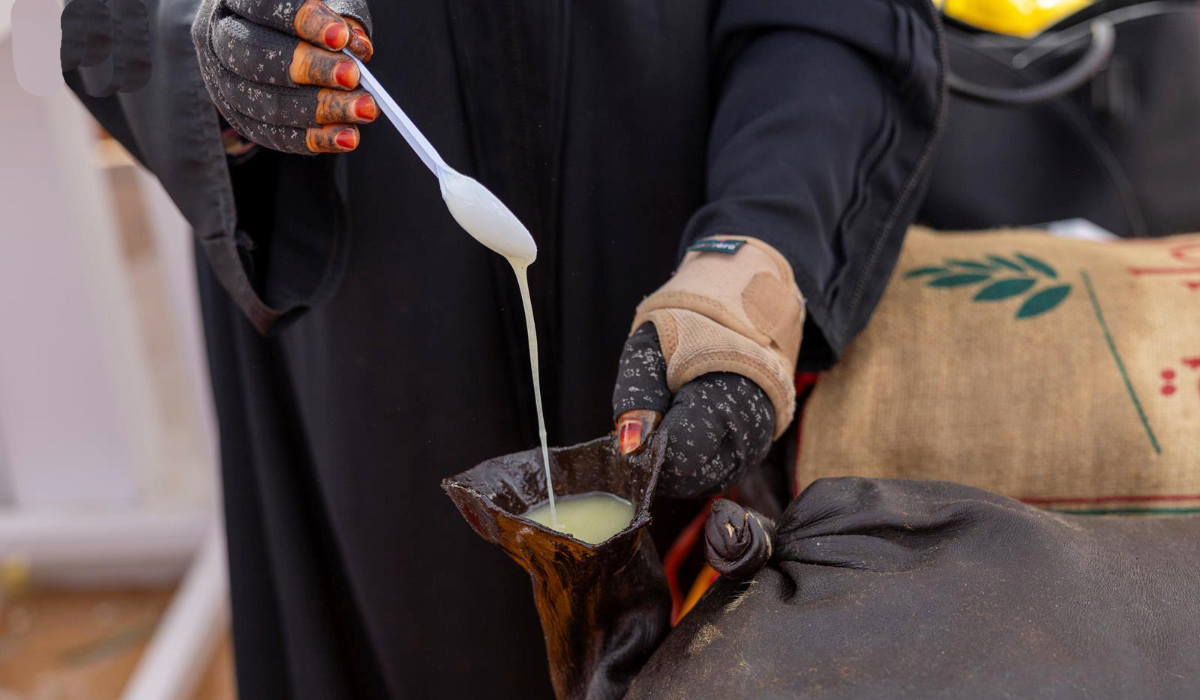
At the camel auction, which ends on Tuesday, craftswoman Umm Meshaal, told the Saudi Press Agency how she produced sameel, a type of pouch made from animal hide and used for storing ghee, yogurt and water.
Meshaal said that sheep skin worked best for keeping yogurt, while goat skin was better for ghee.
FASTFACTS
• At the Jouf camel auction, craftswoman Umm Meshaal told the Saudi Press Agency how she produced sameel.
• It is a traditional pouch made from animal hide and used for storing ghee, yogurt and water.
The process starts by tanning the skins using a tree extract and salt to remove the hair and any impurities. The hides are then left to dry before being cut and sewn together into the desired shape.
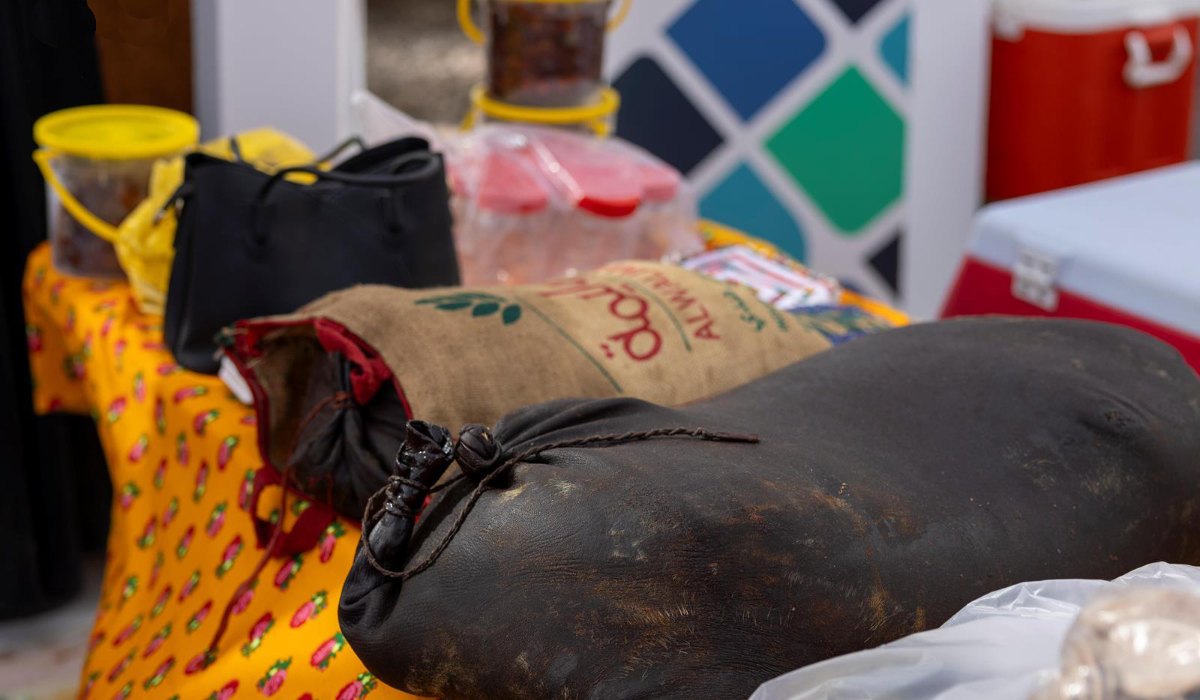
The ancient art of making sameel is still relevant in modern-day Jouf, particularly among Bedouin communities who use them for storing and carrying vital supplies.
Many consumers say the best ghee in the Kingdom comes from these traditional vessels, the report said.
A look at NEOM’s prehistoric masterpieces etched in stone

- Open-air museum of ancient artworks is key to decoding past civilizations
- Drawings reveal how human beings interacted with now-extinct animals in the area
MAKKAH: In the heart of NEOM’s Hisma Desert, where sandstone mountains and plateaus rise from the arid landscape, is an extraordinary collection of ancient rock art and archaeological inscriptions. These priceless treasures illuminate the cultural and economic vitality of long-lost civilizations.
Once a vital corridor for caravans travelling the ancient trade routes of the Arabian Peninsula, this region preserves an invaluable legacy etched into its geological formations.
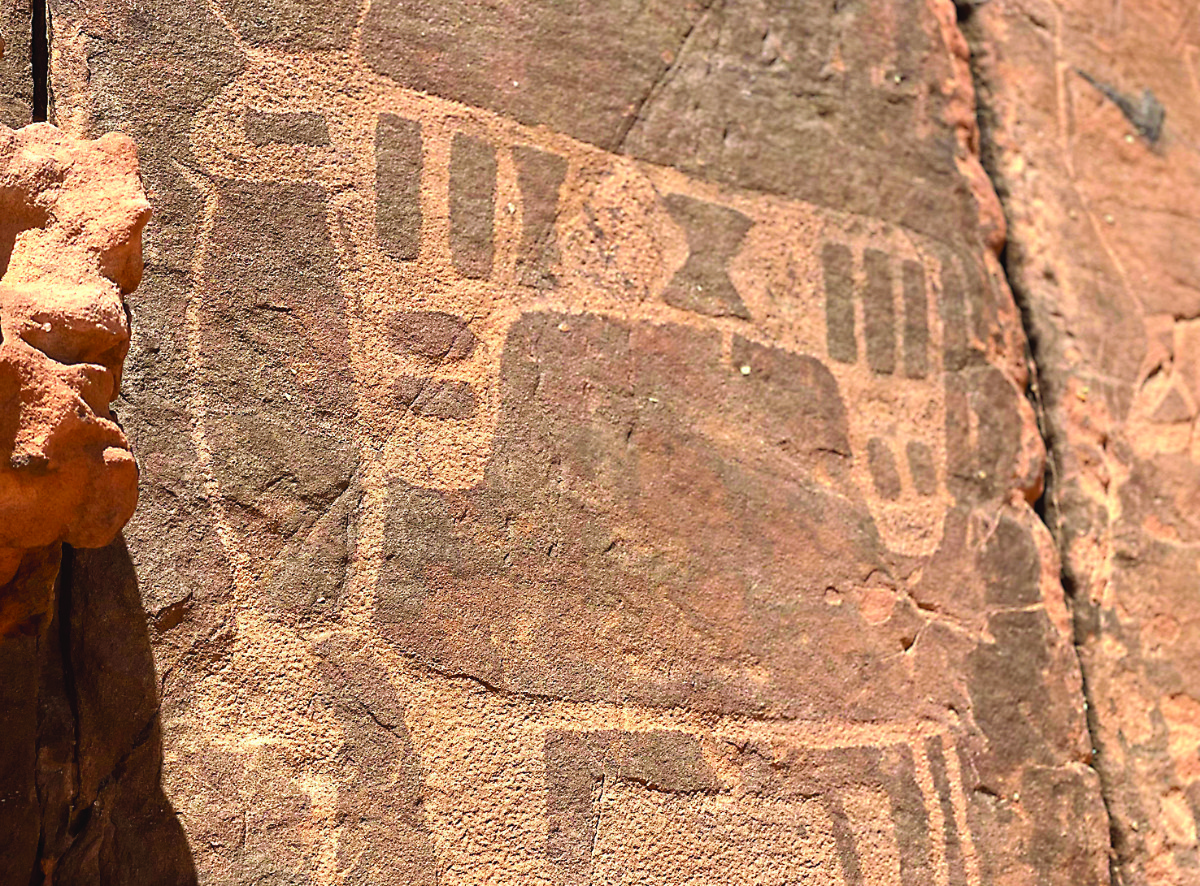
Abdulelah Al-Fares, a photographer and expert in ancient artifacts and a member of the Saudi Heritage Preservation Society, told Arab News that the rock art is in the mountains and plateaus in NEOM, part of a mountain range in the northwestern part of Tabuk.
Hisma Desert is bordered by the Sharah Mountains to the north, by Wadi Araba to the northwest, by the Hijaz Mountains to the west, and by Harrat Al-Raha to the south.
HIGHLIGHTS
• Studying rock art in the region matters deeply because it reveals economic and cultural changes that shaped the northern Arabian Peninsula.
• The drawings show how people interacted with now-extinct animals in the area, as well as with livestock and camels.
• Among the standout examples are life-sized camels crafted with remarkable precision and aesthetic detail.
“The plateaus, part of the Hisma Desert and its geological formations, represent an open-air museum of nature, ancient rock art, and diverse historical inscriptions,” he said.
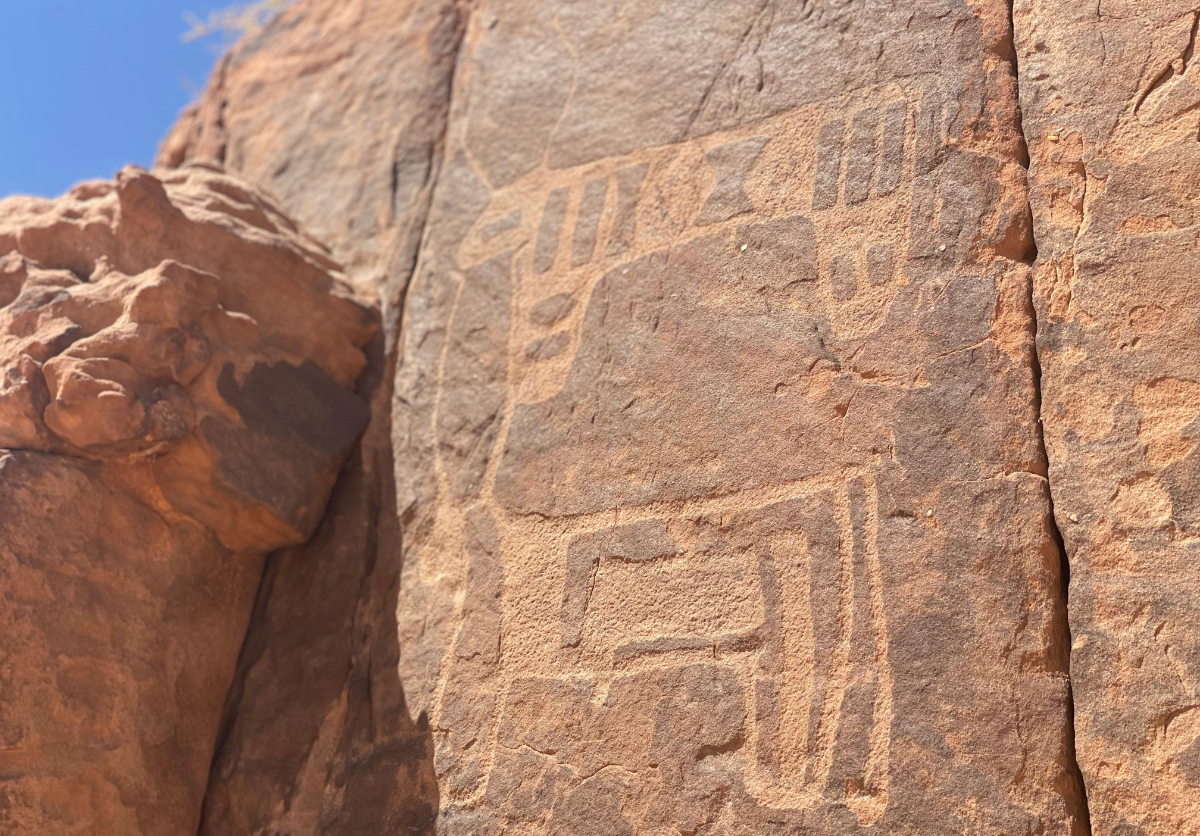
The rock drawings feature engravings of human figures, animals and various scattered scenes throughout the site.
The engravings on the plateau’s facades depict scenes of animals, including wild animals such as camels, cattle, ibexes, ostriches and wolves, as well as other predatory animals, and depictions of hunting scenes and human combat.
These drawings are notable for their precision and have remarkably withstood the elements for thousands of years.
Abdulelah Al-Fares, Saudi Heritage Preservation Society member
“These drawings are notable for their precision and have remarkably withstood the elements for thousands of years,” he said. “Most of the themes and scenes in some of the rock drawings in the region are repeated and depict, to some extent, the world of wild animals and the interactions of humans through hunting and warfare.
“The mountains embody a civilizational and cultural legacy through their distinctive rock drawings featuring human and animal forms,” Al-Fares said.

He also highlighted the value of exploring NEOM’s ancient rock art. These carvings — depicting animals, hunting scenes and human figures — are a bridge between our modern lives and the world of humans thousands of years ago. They are a source of cultural and historical knowledge.
The artworks also illuminate the journey of human civilization, revealing its cultural and social evolution in the region.
Scattered throughout the area, a wide array of rock art sites show a vast and dense collection of drawings and archaeological inscriptions from different eras etched on mountain surfaces.
Al-Fares pointed out their diversity, noting the varied artistic styles, forms, and themes that distinguish each piece.
Among the standout examples are life-sized camels crafted with remarkable precision and aesthetic detail. The careful attention to detail is thought to underscore the camel’s role as an essential sources of food and transport in ancient times.
Another façade shows a herd of cows, all facing forward, their large crescent-shaped horns curving at the tips. Encircling this herd, human figures of varying sizes are skilfully carved.
These ancient artworks are pictorial panels of human history, activity, environmental adaptation, and cultural development during ancient times. Their value shines brighter given the scarcity of insights into prehistoric life.
Studying rock art in the region matters deeply because it reveals economic and cultural changes that shaped the northern Arabian Peninsula.
The drawings show how people interacted with now-extinct animals in the area, as well as with livestock and camels.
Many carvings portray human beings astride animals, including a warrior wielding a spear and sword, rendered with finesse and skill.
Scattered throughout the region, some drawings hint at the presence of different ethnic groups that lived in the area. The provide clues to migratiosn and trace the routes of trade caravans that used these locations as settlement points.
Saudi Arabia’s Hail poppy reserve attracts thousands of tourists

- Since opening in 2022, the reserve, which covers 10,000 sq. meters, has drawn thousands of domestic and foreign visitors
HAIL: With its vibrant array of wildflowers framed by golden sand dunes and majestic mountains, the Poppy Reserve in Al-Khattah is one of the Hail region’s most captivating attractions.
Since opening in 2022, the reserve, which covers 10,000 sq. meters, has drawn thousands of domestic and foreign visitors, particularly during holidays, Eid and the spring season.
The attraction enchants guests with its sweeping fields of poppies, perfectly balanced in form and color. As the sun sets, the golden rays cast a warm glow over the landscape and create a natural wonder.
This striking beauty enhances the region’s reputation for breathtaking scenery and offers a unique experience.
Madinah Retreats: Culture, spirituality to power up the soul

- Paradigm shift blends wellness practices, cultural expeditions, spiritual experiences
JEDDAH: In the sacred embrace of Madinah, one of Islam’s holiest sites, a new culture-oriented wellness experience is offering a journey that integrates spirituality, culture, and heritage.
The inspiration behind Madinah Retreats stems from founder Moatassem Al-Bitar’s experience in the wellness and spiritual tourism industry in Saudi Arabia and beyond.
Recognizing key gaps in traditional retreat models and leveraging Saudi Arabia’s tourism vision, he envisioned a paradigm shift that blends modern wellness practices, cultural expeditions, and spiritual experiences into a single journey.

With a background as a corporate culture change and people engagement manager, Al-Bitar has curated over 50 retreats across Saudi Arabia, Egypt, and the US, serving more than 400 participants.
His academic training spans diverse fields, including organizational behavior, Islamic spirituality, and intercultural studies.
Officially launched in 2024 after five years in the making, the initiative held its second retreat, under the theme “The Arrival,” earlier this year in Madinah.
FASTFACTS
• Madinah Retreats stems from founder Moatassem Al-Bitar’s experience in the wellness and spiritual tourism industry in Saudi Arabia and beyond.
• It blends modern wellness practices, cultural expeditions, and spiritual experiences into a single journey.
Al-Bitar told Arab News: “Every retreat we design starts with clear intentions and objectives, supplemented by a story and a theme that aligns with a particular destination.”
The retreats feature a collective of facilitators who work together toward a unified intention, ensuring a balanced and immersive experience.
“One of our main goals is to promote different destinations in Saudi Arabia that are perfectly ideal for wellness-centric experiences, in addition to its unmatched culturally enriching character,” Al-Bitar said.
“We seek to partner with pertinent governmental initiatives and entities that fulfill the Kingdom’s Vision 2030 for wellness tourism and exceptional experiences.”
Al-Bitar explained that each retreat is meticulously structured around three core pillars: spirituality (meditative practices and inner reflection); culture (heritage site visits, traditional storytelling, and local experiences); and wellness (movement–based practices, mindfulness exercises, and healing foods).
By integrating these elements into daily programs, Madinah Retreats offers a journey tailored to the needs of participants and is a “philosophy of being rooted, real, and rich.”
The retreats target individuals and groups seeking genuine transformation in their well-being, spiritual connection, and cultural enrichment. They provide a safe and accepting space where participants are respected on their unique paths to healing.
Madinah, which is the spiritual capital of Islam, is popularly known as the Illuminated City. It offers an atmosphere of peace and rejuvenation, and its diverse topography and climate make it ideal for nature-based healing.
“Madinah is widely recognized as a destination where the heart feels at peace, the body feels rejuvenated, the mind feels clarity and the soul feels enriched,” said Al-Bitar. “The city’s rapid development and recognition as a top global tourism destination further enhance its appeal.”
The Madinah Retreats experience is usually hosted in a traditional farm resort surrounded by nature. Participants visit cultural and historic sites, explore the city’s vibrant social scene, and experience local cuisine, contemporary art, and community traditions.
“During the retreat we offer meditation, breathwork, self-reflection, yoga, tai chi, and other somatic therapies, creative expression as a healing tool, as well as locally sourced, nourishing meals,” Al-Bitar added.
The somatic practices guided by expert facilitators enhance body awareness and overall well-being.
Al-Bitar said: “Connecting with nature and animals has proven therapeutic benefits. Madinah Retreats incorporates nature-based and equine therapy to help participants reconnect with their original disposition, providing an irreplaceable form of healing.”
Cultural storytelling is also an essential component, allowing participants to explore the hidden wisdom of each landmark and understand local traditions and historic practices.
No prior experience in meditation or wellness practices is required, making the retreats accessible to all.
Honoring his Egyptian roots, Al-Bitar is expanding the retreats to Siwa, Egypt.
Siwa Oasis, nestled within a breathtaking desert landscape, is characterized by vast dunes, striking limestone outcrops, and distinctive geomorphological features that enhance its appeal as a tourist destination.
“The expansion to Siwa, Egypt, was inspired by the oasis’ 160-year-old tradition of reconciliation — Eid El-Solh, a celebration of harmony,” Al-Bitar said.
“Siwa’s natural healing elements, such as salt lakes, hot springs, and lush landscapes, mirror many of Madinah’s restorative qualities.”
Al-Bitar said that Madinah Retreats will also explore the Kingdom’s hidden gems by hosting retreats in Abha, Aseer, Al-Ahsa, and other locations rich in healing nature and cultural heritage.
Retreat prices range from SR5,000 ($1,333) to SR10,000, depending on the location, program, facilitators, transportation, and accommodation.
Madinah Retreats follows a collaborative model, partnering with local service providers, facilitators, and experts to provide an experience that remains true to the cultural essence of each destination.
Al-Bitar said: “Our content caters to people from different backgrounds, both English and Arabic speakers. Our agenda is characterized by being spacious and offers ample time for self-guided practices. Our way of delivery is strictly non-intrusive.”
Participants leave Madinah Retreats feeling “transformed, enriched, and connected to their most authentic selves.”
Al-Bitar said that the experience embodied the profound wisdom: “You presume you are a small entity, but within you is enfolded the entire universe.”
Madinah Retreats also provides a customized retreat model that caters to corporations and teams, as well as add-on visits such as expeditions in AlUla.


